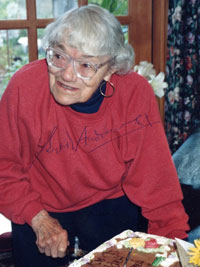
Sybil Andrews 94th birthday
Quick links on this page
War Service 1914
Cyril Power 1916
London Heatherleys 1922
Woolpit 1926
Hammersmith Studio 1928
Break with Power 1938
War Service again! 1942
Emigrate to Canada 1947
Banner of St Edmund 1975
Sybil dies age 94 1992
Sybil Andrews Academy 2015
Foot of Page
|
Local Artist Sybil Andrews
Britain and Canada
(1898 - 1992)
|
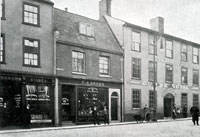
Andrews Store seen in 1907
|
|
1898
|
Sybil Andrews was born on April 19th, 1898, the third child of Charles Andrews and Beatrice Trigg. She was born at 88-90 Guildhall Street above Andrews ironmongers shop, a business founded by Sybil's grandfather, Frederick Charles Andrews. Sybil's father was a partner in the firm. They lived over the shop until 1901.
Also in 1898, a nephew of Mr Andrews, called Robert Philip Plumpton, was invited to join the business. Plumpton had been living in Peterborough where he was already working as an ironmonger.
By 1901 the shop was called Andrews and Plumpton, which survived on its commanding site looking down Abbeygate Street, until 1988. The room where Sybil was born is illustrated in a sketch showing Andrews and Plumpton by Cyril Power, made after he met her, in 1918.
Sybil's other grandfather was Henry Trigg, (1838-92) who had altered his name from Prigg, and had been a well known local antiquarian. He was the author of "The Icklingham Papers", an archaeological investigation of the remains of the Roman villa at Icklingham, although the book was not published until 1901, and was confusingly published in the name of Henry Prigg. Local interests and local history played a big part in Sybil's early life, and her 1936 linocut 'Tumulus', was a memory of Rampart Fields at Icklingham.
Sybil would gain an international reputation as an artist after leaving Suffolk to move to London in 1922.
|
|
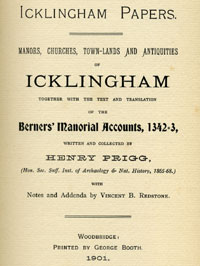
The Icklingham Papers
|
| 1901 |
The Icklingham Papers were published in 1901 by Henry Prigg's daughter, Mrs Beatrice Andrews, who had accompanied him on some of his antiquarian excursions. The book was introduced by Vincent Redstone, and contained copies of manorial documents and wills from the village, together with an account of the archaeological investigations of some of the antiquities of Icklingham. Prigg showed that a Roman villa and cemetery had existed on the site and he also excavated the tumuli and found pottery kilns at nearby West Stow Heath. Prigg had worked at the National Provincial Bank in Bury, until he retired four years before his death in 1892. He lived at Babwell Friary, and having died in his early 50's he did not have time to put his work in order for publication, but his daughter decided the work needed to be properly published.
Henry Prigg's daughter, Beatrice, was married to Charles Andrews, who at this time, had just left the family business, due to illness. In about 1901 the family moved out of the rooms above the shop into Greyfriars in Whiting Street.
Many of the antiquities unearthed by Prigg over a lifetime of excavation were exhibited at first in the Athenaeum, and then were to form the core of the Moyse's Hall Museum collection when it was set up in 1899. The fifth child of Beatrice and Charles Andrews was called Henry (1904-1961), and he would become Curator of Moyse's Hall Museum himself in 1933.
|
| 1905 |
In about 1905 the Andrews family suffered another setback. Due to Charles's continued illness, the family had to move from Greyfriars on Whiting Street, to a smaller home at 117 Northgate Street.
By now there were five children and although they still lived a comfortable middle class life with servants, it meant that Sybil, the third child, grew up to be more self reliant and independent than might otherwise have been the case.
|
|
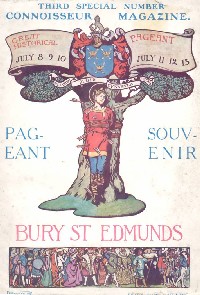 Pageant Souvenir
Pageant Souvenir
|
|
1907
|
For two years, Archdeacon Hodges, the Vicar of St James's, had been planning a great pageant to celebrate the historical past of Bury St Edmunds. An American called Louis Napoleon Parker was hired to be the Master of the Pageant, a job he had experience of elsewhere in the country already. The aim was to explore seven historical incidents from Roman times down to the visit of Queen Elizabeth in 1578.
Thus in July 1907 the town held its Grand Pageant of St Edmund to commemorate the historical past of Bury St Edmunds. It was performed in the Abbey Gardens, and involved two thousand local people as actors, organisers, costume makers or stage hands. St Edmund was played by Dr Stork, and in a family like the Andrews of Andrews and Plumpton, the whole household were involved, including all the servants, and even 9 year old Sybil Andrews took part.
|
|
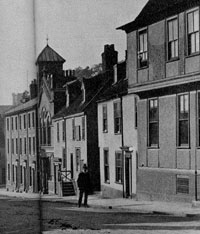
Looms lane junction c1920 |
|
blank |
Sybil Andrews recalled in her later years that at this time Looms Lane was narrow, with high walls on either side. On market days it was not unusual to meet a herd of cows being driven from market along Looms Lane, leaving pedestrians little room to avoid them. She would paint Looms Lane in 1921. The photograph here shows how narrow Looms Lane was at its junction with Northgate Street. The houses visible here in Northgate Street, flanking either side of Looms lane, have since been demolished in the 1960's for road widening purposes.
|
| 1914 |
Civilians were no longer immune to the needs of war. Young women like Sybil Andrews might be called upon to help. She went off to London to train as a welder, and was sent to Coventry to weld aeroplane parts. Later she would be moved to Bristol to weld the very first all metal planes for the Bristol Welding Company.
|
|

Cyril Power RAF WWI
|
| 1916 |
Cyril Edward Power was born in Chelsea in 1872. His father was an architect who encouraged him to draw and to study architecture. Cyril would qualify as an architect in his father's firm.
Cyril Power had married local Bury St Edmunds girl Dorothy Mary Nunn on 27th August, 1904, at Bury St Edmunds. They set up home in Kenilworth Court, Putney, London.
Having had a successful architectural career in London, he had been a lecturer at University College London, and had also published three volumes entitled "History of English Medieval Architecture".
In 1916 Power had joined the Royal Flying Corps. As he was 44 with a technical background, he was posted into the RFC workshops and became manager of aerodrome repairs at Lympne. After the war he would move to Bury St Edmunds with his family and there meet Sybil Andrews and have a profound effect upon her artistic development.
|
|

Sybil Andrews in 1918
|
| 1918 |
At the end of the war, Sybil Andrews returned to Bury St Edmunds, having been away on vital war work for the duration. She had been a welder working on aeroplane parts; firstly in Coventry and then in Bristol, where this photograph was taken.
In her few spare hours she had started "John Hassall's Correspondence Course" in basic art studies. By late 1918 she was still taking the correspondence course in art, and was determined to pursue this at nights, after teaching during the day.
She came to live in Bury St Edmunds with her mother at 117 Northgate Street, and taught at Portland House School to pay her way. Her father, meanwhile, had gone to Canada in 1910, where he would die in 1922.
In 1918, after demobilisation, the Power family moved to 4 Crown Street, Chequer Square in Bury St Edmunds where Cyril Power recommenced an architectural practice.
Cyril Power first met Sybil Andrews in 1918 when she was struggling over a drawing of a house in Bury town centre. As he was well versed in the art of architectural drawing, he offered to give her some tuition. This meeting seems to have inspired them both to a period of artistic creativity.
Cyril Power and Sybil Andrews would have an artistic and professional relationship from 1918 until 1938.
|
|
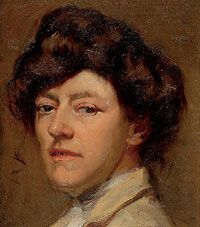
Rose Mead self portrait 1910
|
| 1919 |
Rose Mead's mother died at the age of 92. Rose Mead had started an international art career until being called home to Bury to nurse her mother in 1897. By now herself 52, Rose Mead had lost her ambition for national exhibitions, and would remain a well known and respected local figure, but little known on the wider scene. However, many local artists were grateful to her for help and encouragement in their early years, including Sybil Andrews. She remained a prolific painter of portraits, as well as a wide range of other subjects, right up to her death in 1946. She was producing excellent work in her Crown Street studio throughout the 1920's and 30's.
|
|

Crescent House
|
|
blank |
In late 1919 Sybil Andrews set up her first studio in a second storey room in Crescent House, number 28, Angel Hill. She would have been 21 years old. Cyril Power also took a studio in the same building, but at the rear, overlooking the Abbey Gardens. Power had a long background in art, and was to encourage and guide Sybil in her drawing of street scenes of the town. As Sybil was only just striking out at this time, she had a lot to learn from Power.
|
|
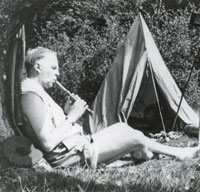
Cyril Power by Sybil Andrews 1936
|
| 1920 |
By 1920 Cyril Power was designing alterations and additions to Chadacre Hall to create an Agricultural College for Lord Iveagh. After the war Lord Iveagh felt such a facility was needed in this area. (It continued as a college until 1988.) During this period Cyril Power was also producing watercolour landscapes and townscapes as well as the first of some 40 drypoints.
|
|
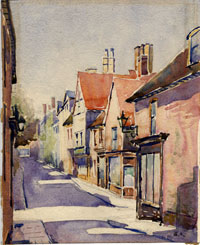
Hatter Street
Sybil Andrews c1920/21
|
|
blank |
This hitherto unrecorded picture of Hatter Street has the monogram SA and is undoubtedly by Sybil Andrews. It was sold on E-Bay by northnorfolk artcentre in June 2010, with the note: "Provenance: All items I sell have been amassed by an art specialist over a period of forty years". It shows the style in which Andrews was working in these beginning years in Bury St Edmunds, and may have been originally acquired from the exhibition which Power and Andrews would stage in 1921.
|
|

Looms Lane 1921
Sybil Andrews
|
| 1921 |
During 1921 Sybil Andrews worked as much as she could on her watercolours and pastels, exploring what media she could in order to improve her technique. Power would set her in front of the most difficult architectural views that Bury could offer and then advise her where she might be going wrong.
Power was also producing more work in this year and they soon amassed a body of work which they felt could be exhibited for sale to the public.
|
|
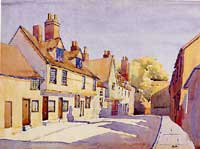
Southgate Street 1921
Sybil Andrews
|
|
blank |
In December 1921, Cyril Power and Sybil Andrews held their first joint public exhibition of 95 watercolours and 50 pastels. It was held in their studios in Crescent House on the Angel Hill, in Bury St Edmunds. The year 1921 seems to have revitalised Power's interest in art, inspired, perhaps, by the enthusiasm to learn from him expressed by Sybil Andrews.
|
|
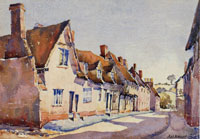
Water Street Lavenham
|
|
blank |
Their work was reviewed in the Bury Post as of the "modern school of painting", and "revolutionary and difficult for the lay mind to appreciate." Nevertheless, the critic went on to praise their approach, but it shows that Sybil Andrews was thought radically different at the time from an established traditional stylist like Rose Mead.
|
|
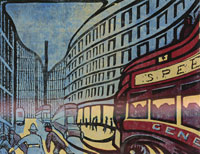
Speed - Claude Flight 1922
|
| 1922 |
By 1922 Claude Flight was making linocut prints which were regarded at the time as avant garde. He would bring such work to demonstrate the techniques available when he began to teach at the Grosvenor school in 1926.
In 1922, both Sybil Andrews and Cyril Power enrolled in Heatherley's School of Fine Art in London, Sybil paying for her year's tuition with a small inheritance. She soon moved to a small flat near Russell Square, taking her mother with her. Heatherley's was a well established college, with many distinguished alumni. Claude Flight studied there in 1912.
The Principal at Heatherley's was Henry G Massey, who also taught a weekly Composition Class. Sybil acknowledged the importance to her of these classes. Otherwise the work there was all Life drawing and painting in oils.
A visiting lecturer at Heatherley's was William Kermode who provided lessons on woodblock printing in black and white. Sybil took to woodblocks with enthusiasm.
|
|

Low Tide Limehouse 1923
Sybil Andrews
|
| 1923 |
In London Sybil Andrews was completing her year at Heatherly's when she set up her own studio at 4 Phoenix Place, Addison Avenue, Notting Hill. "I worked hard there when I was at Heatherley's."
After Heatherleys she took some lessons from sculptor Henri Glicenstein. He taught her the drypoint on to copper plate technique which would be her means for making a living in the commercial field of art, making prints which could find a ready market with the public.
In 1923 Cyril Powers' family moved from Bury St Edmunds to St Albans. Power would still visit the Bury St Edmunds area with Sybil Andrews occasionally.
|
| 1924 |
In 1924 Andrews and Power attempted to address their own artistic aims and aspirations. They created an unpublished document called, "Aims of the Art of Today". At the very least it tells us that they were attempting to create new styles of art that rejected the "pretty pictures" of the past.
|
|
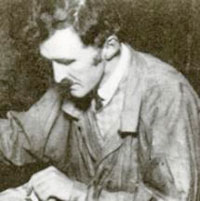
Claude Flight 1925
|
| 1925 |
In 1925 Cyril Power would help Iain MacNab leave his post as joint Principal at Heatherleys School in order to set up the Grosvenor School of Modern Art at 33 Warwick Square, London. Sybil Andrews would become the School Secretary until 1928 enabling her to earn a living and get free tuition in her time off.
They would learn to make colour linocuts under the influence of Claude Flight who was engaged in 1926 to teach the medium at the school. Flight's revolutionary approach to the linocut was partly political. He wanted to create democratic art, where the materials were cheap and the general public could, he hoped, buy a good picture for the price of a pint of beer. This was to prove unrealistic, but his view that art should reflect everyday working life had a profound effect. He also demonstrated how multiple blocks could be used to make a two, three and even four colour print using simple tools and without needing a printing press. Flight taught at the Grosvenor until May, 1930.
Cyril Power became the Grosvenor's Lecturer on architecture, and Frank Rutter taught art history.
|
|

Rouen 1925
|
|
blank |
In London Sybil had already learnt about woodblock printing from William Kermode, and her aim became to eliminate all unnecessary detail from her work, and to imbue the image with energy. She would live and work in London until the war, occasionally returning to Bury to visit relatives and, after 1926, to stay at the house in Woolpit.
A short holiday to St Malo and Rouen in France during 1925 produced two monotypes of the area from Sybil Andrews.
|
|

Tyrrells by Cyril Power
|
| 1926 |
In May, 1926, Sybil Andrews' mother Beatrice Andrews purchased a small house in Woolpit which was lot 6 in an auction sale of 13 properties of the Woolpit House Estate. The intention was for Beatrice to live there while Sybil carried on her work in London. She had a post at The Grosvenor School of Modern Art as School Secretary while studying linocuts in the evenings under Claude Flight who came to teach there in 1926.
Beatrice had always been interested in history and named the cottage at Woolpit "Tyrrells", as her great grandmother, Ann Maria Browse (1772-1828) was a member of the Tyrrell family of Gipping Manor, near Stowmarket.
During holiday periods Sybil and Cyril Power would stay at Woolpit as well, entering village life and experiencing the work lives of agricultural workers. These rural scenes made a strong impression upon Sybil Andrews which would be remembered in her later work, long after leaving Suffolk for Canada.
The house was very picturesque, although very small and lacking in comforts, but inspired Cyril Power to create this monochrome linocut picture of it, standing at the junction of Mill Lane and Green Road. The date of the picture is uncertain, but Coppell's catalogue raisonné places it as circa 1926.
|
|

All Souls College Oxford
|
| 1927 |
Although Sybil tended towards abstraction and feeling in her "art", she still had to eat. Throughout the later 1920s and into the 1930s she would earn her living from the sale of architectural etchings and drypoints, as taught to her by Henri Glicenstein.
This example is entitled All Souls College Oxford. The architectural knowledge gained from her tutelage by Cyril Power was put to good use in these works. Prints of Cambridge and Oxford Colleges and well known London landmarks kept her in "bread and cheese", as she expressed it, for some years.
|
|
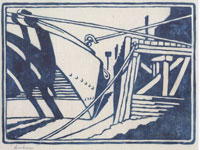
Limehouse 1926
|
| 1928 |
In 1928 Sybil resigned from her job at the Grosvenor School of Modern Art, and moved into a new studio at Brook Green. This had previously been the home of the Hammersmith School of Art.
By 1930 Cyril Power and Sybil Andrews were working together in the Hammersmith studio until 1938.
Sybil was still finding her own voice in lino cutting at this point. However, Limehouse of 1926 is radically different in vision from her Limehouse drypoint of 1923. Note the border around the print which copied the borders traditionally used in wood blocks. The Grosvenor School would soon discard the traditional border and future prints would be contained by the mounting frame itself.
Hammersmith was close to the River Thames, a location which inspired many prints by both artists.
|
|
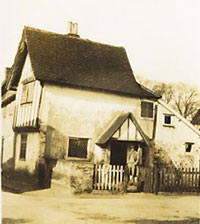
"Tyrrells" Mill Lane Woolpit
|
| 1929 |
Sybil's mother Beatrice died in 1929 in London, as she was staying with Sybil's eldest brother Geoffrey, at the time. Beatrice bequeathed Tyrrells to Sybil. Sybil's sister Margaret, lived in the cottage till 1932, before she too left and, owned a tearoom in Ipswich. The cottage remained in use by the Andrews' siblings for Christmas, and other holiday times during the year until 1938.
The cottage name "Tyrrells" persists to this day.
|
|

Concert Hall 1929
|
|
blank |
By 1929 Sybil Andrews' linocuts were becoming very different to her earlier efforts. The simplified shapes and soaring curves show the Queen's Hall in the best possible light. It was a notoriously ugly building but enjoyed perfect acoustics. The traditional border has now been discarded.
|
|
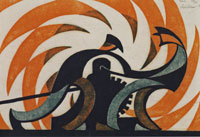
The Winch 1930
|
| 1930 |
Sybil was now fully in her stride and would produce 40 different colour prints in the years up to 1938. The Winch shows the interaction of man and machine, a theme which Sybil often employed, while more traditional artists were still pursuing what Sybil might call "pretty pictures".
|
|
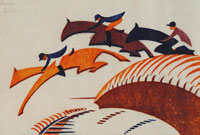
Steeplechasing 1930
|
|
blank |
With her print entitled "Steeplechasing" of 1930, Sybil managed to combine abstraction and dynamic movement with a subject beloved by all sectors of the public. Steeplechasing with only 3 colour blocks became so popular that it went into three editions. The first edition of 50 prints was for UK consumption. In 1932 she made a 60 print edition for the USA market, and in 1936 she started a 3rd edition to meet Australian demand. Unfortunately only 20 prints were made for Australia before the blocks gave out.
|
|

Golgotha 1931
|
| 1931 |
Golgotha was the first print made by Sybil Andrews on a religious theme. She would continue to make numerous religiously themed works for the rest of her life, including an unfinished series of the fourteen stations of the cross.
She followed the teachings of Mary Baker Eddy, (1821-1910), founder of the Church of Christ, Scientist, and the periodical Christian Science Monitor. These beliefs were based upon a study of the Bible and the importance of the Crucifixion and Resurrection of Christ. Spiritual healing by the power of prayer was also emphasised.
|
|

St Edmund Martydom mural 1932
|
| 1932 |
By 1932 the cottage at Woolpit named "Tyrrells" was empty after Sybil's mother Beatrice had died in 1929, and her sister Margaret had just moved to Ipswich to open a tearoom. However, it was used by the family for weekends, short holiday breaks and Christmases.
Sybil Andrews, her youngest brother, Henry Andrews, and Cyril Power decided to spend the summer there and use the new village perspective to inspire their art. The cottage needed some repairs and decorations.
Family photographs show that there were at one time some wall murals, painted by Sybil, Henry and Cyril Power in 1932. One wall painting depicted King Edmund being slain by the Vikings. Clearly this mural is related to Sybil's tapestry that she donated to St James's in Bury St Edmunds in 1975.
Sybil Andrews always retained a deep interest in the history and life of Bury, having apparently started work on her great Banner of St Edmund in the 1930s. It would become a masterpiece of embroidery, but was not completed until 1975.
|
|
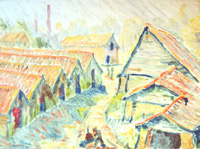
Woolpit Brick Sheds
Cyril Power
|
|
blank |
This monotype of the Brick Sheds at Woolpit emphasises the connection between Andrews and Power. She also produced a monotype of the same subject, and in the same style. Once again the subject is from their experiences in Woolpit during visits, but the picture may be from a little later, perhaps after 1933. This a second impression from the print, which accounts for the weaker colouring. Usually only one impression is kept from a monotype.
|
|
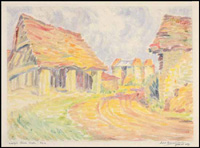
Woolpit Brick Sheds
Sybil Andrews
|
|
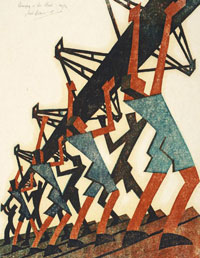
Bringing in the Boat 1933
|
| 1933 |
The Hammersmith studio where Sybil worked was close to the River Thames, a location which inspired many prints by both artists, most notably 'The Eight' by Power and 'Bringing in the Boat' by Sybil Andrews.
In 1933 Henry Andrews was appointed curator of Moyse's Hall Museum, a post he would hold until 1939. Henry was the youngest brother of Sybil Andrews, and Sybil would visit him in Bury, and occasionally sketch in and around the museum.
|
|
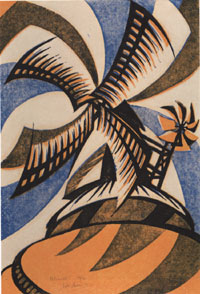
Windmill 1933
|
|
blank |
In January of 1933, Sybil Andrews enjoyed a joint exhibition with Cyril Power of linocuts and monotypes, at the The Redfern Gallery, in London. Her work was also included in the exhibition "Colour Prints," at The Redfern Gallery in June of that year. She was attracting a lot of attention in the art world.
Another of her linocuts from this period was this picture of Elmer's windmill at Woolpit. Although produced in 1933, it was probably produced from sketches and memories made when she lived briefly at Woolpit during visits in and after 1926.
|
|

Monotype portrait of Cyril Power 1933
|
|
blank |
It is clear from this monotype portrait of Cyril Power that Sybil Andrews was a completely capable artist in a whole range of media. She could render reality with as much facility as she rendered the more abstracted subjects of her lino cuts.
|
|
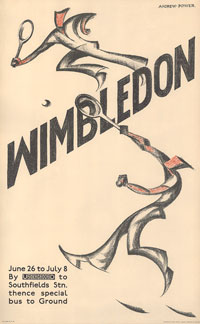
Wimbledon poster for London Transport 1933
|
|
blank |
According to the London Transport Museum,
" This is one of two posters commissioned by London Transport in 1933 to promote the annual tennis tournament at Wimbledon. It was designed by Sybil Andrews. Whilst studying at the New Grosvenor School of Modern Art in London, Andrews shared a studio with Cyril Power. Power was later instrumental in obtaining poster commissions for her from London Transport. She acknowledged this by signing the work 'Andrew Power'. The other Wimbledon poster commissioned that year, designed by E A Marty, was in a far more conventional style. By issuing two very different posters, London Transport could appeal to a broader audience."
Elsewhere on the ltmuseum website there is a poster advertising the Derby and Epsom Summer Meeting. The museum has a slightly different opinion here:
" The poster is signed Andrew Power. This was a composite signature used by the Grosvenor School artists Sybil Andrews and Cyril Power. They produced seven posters for London Transport that year."
Further posters followed in 1934, including The Lords/Oval and the Aldershot Tattoo.
|
|

Lords Oval 1934
|
| 1934 |
This is a poster produced for London Transport promoting Lords Cricket Ground, and The Oval. Once again it is signed Andrew Power, and some gallery catalogues treat this name as a separate individual from Sybil Andrews.
|
|
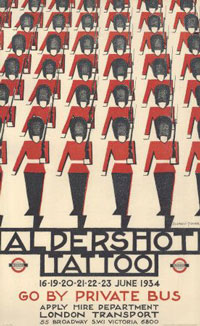
Aldershot Tattoo poster 1934
|
|
blank |
The Aldershot Tattoo poster demonstrates a typical Andrews technique of repetition of a host of stylised figures within the picture.
|
|

Tillers of the Soil 1934
|
|
blank |
Working on posters for London Transport was a valuable commercial commission, but Sybil's prolific work output in this period was also a time of great inspiration for her.
This powerful image of rural life shows a plough team of Suffolk Punch heavy horses pulling a plough over a slope. Sybil loved horses and often depicted horse races and heavy working horses in her work. She captures both effort and fluid movement in this memorable image. (This print would later be used to illustrate the cover of Hana Leaper's "Sybil Andrews Linocuts" of 2015.)
|
|
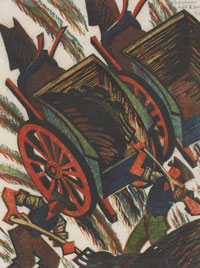
Michaelmas 1935
|
| 1935 |
Michaelmas is a truly rural scene of muckspreading after the harvest to revitalise the soil. Strength, hard work, a rural scene and a harmony of form are some of Sybil's recurring themes throughout her life.
|
|
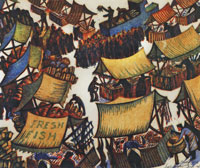
Market Day 1936
|
| 1936 |
Many of Sybil's local sketches were used to recapture her home town. This work entitled Market Day typifies the views she had in Bury at this time. She herself wrote,
"Market Day 1936 typifies the whole life of an agricultural town like Bury St Edmunds. Without it there would be no reason for its existence."
Market Day contains a lot more small detail than is normal for Andrews, which demonstrates that she was equal to Power in this regard, but generally chose to concentrate on form and movement.
The linocut of Market Day was conceived at Moyse's Hall Museum, where her brother Henry had been the curator since 1933. It is a view from one of the upstairs windows at the Museum.
|
|

The Hammersmith Studio in 1936
|
|
blank |
The Hammersmith studio is seen here in 1936. Note the musical instruments on the walls. As well as the stringed instruments, Sybil had a large collection of recorders and she and Power would play these for recreation.
|
|
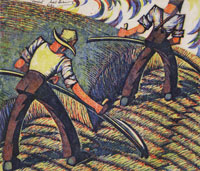
Haysel 1936
|
|
blank |
Sybil produced a number of remarkable pictures in and around 1936, including "Tumulus", "Market Day" and the evocative "Haysel" shown here. Here the repetitive stance of the hay mowers is not an artistic artifice. The mowers had to swing in harmony in order that the scythes did not clash or cause serious injury to the other man.
|
|
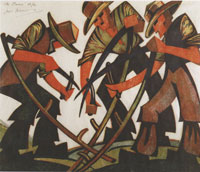
Mowers 1937
|
| 1937 |
By 1937 Sybil had demonstrated many times that she was in full control of the lino cut technique. Each colour was printed from a separate block which required meticulous control while also realising her vision of rhythm and balance of forms.
In the same year she made "Footballers" translating a muscular football tackle into the simplest elements of form, while also conveying a sense of action.
|
|
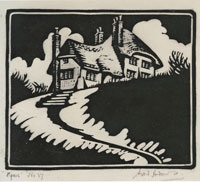
'Pipers' Christmas card 1938
|
| 1938 |
Following several joint exhibitions the artistic working partnership of Andrews and Power was dissolved in July 1938 when they gave up their Hammersmith studio. Andrews moved to her cottage 'Pipers', near Lymington on the Hampshire coast which Power had modernised and enlarged the previous year. Later she would comment that this turned out to be a good thing as her old studio had been bombed during the Blitz.
The pair’s relationship, characterized by Andrews as strictly professional, ended with this move in July 1938.
Cyril Power rejoined his family, who had just moved from Hertfordshire to New Malden in Surrey.
Sybil put her Woolpit cottage, "Tyrrells" up for sale in September 1938 and it was finally sold on the 16 October 1938. Tyrrells became a Grade II Listed Building in November, 1954.
|
|
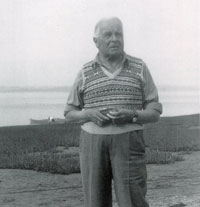
Cyril Power 1940s
|
| 1939 |
In September 1939, at the outbreak of World War II, Cyril Power was attached to a Heavy Rescue Squad as a surveyor, based at Wandsworth Town Hall. He continued drawing and painting, tending to work principally in oils using a palette knife technique. He also spent time lecturing on painting and linocutting to the local art society at New Malden and at Kingston-Upon-Thames.
During the last years of his life Power completed some eighty-nine oil paintings, a format he had grown increasingly fond of in the preceding years. These were mainly landscapes of the surrounding areas, often Helford River and the Falmouth area of Cornwall as well as some floral studies. He died in London in May 1951, aged seventy-eight. Soon after his death all his 45 lino printing blocks were destroyed.
|
|
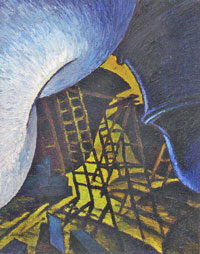
Oil on canvas Boatyard 1942
|
| 1942 |
As World War II continued and women were again called upon to contribute, in 1942 Sybil returned to work as a welder for the British Powerboat Company, near Southampton. While employed there, she met Walter William James Morgan and they were married in 1943. Walter was a boatbuilder, general builder and cabinet maker with developed skills on the lathe. He had always wanted to go to Canada.
Although she made no linocuts during her war work, she did produce a number of oil paintings based on the life and work of the shipyard. However, the abstract forms of ladders and ships hulls picked out in the oil painting could as easily have been reproduced as a Grosvenor School style linocut.
|
|
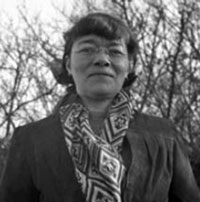
Sybil Andrews in 1947
|
| 1947 |
In these post war years emigration to the colonies such as Australia, New Zealand and Canada came to be increasingly attractive to many people, particularly ex-servicemen. Sybil Andrews and her husband decided that a better life could be found in Canada, and emigrated in 1947. She would never return to her home town of Bury St Edmunds, and had only been a visitor since 1922.
On the passenger manifest of "The Royal Mail" ship, Walter Morgan was recorded as a builder aged 52, and Sybil Morgan was listed as Housewife and Artist. Having arrived in Canada it was found that some of her printing blocks had been damaged by heat in the hold where they were stowed.
Andrews and her husband Walter Morgan explored parts of British Columbia, but finally settled in Campbell River, on Vancouver Island. In 1947 Campbell River was a remote logging town with only fishing and mining as alternative occupations, giving Walter an opportunity to build and repair boats for local fishermen and for local communications.
They had to buckle down to improve their new home and establish their livelihoods in what was a very basic town in a whole new world.
|
|
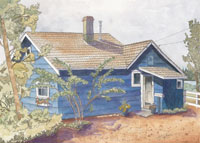
Willow Cottage
|
|
blank |
Having found the remote Campbell River, they settled on the small cottage in Willow Point on Vancouver Island where Walter, aged 53, started his Morgan Boatworks and got to work building and selling plywood runabouts. Willow Cottage was on the oceanfront with views across the Georgia Straits. It was a remote home in a remote town.
Walter also worked for Elk Falls Mill for a number of years. Once his own workshop was ready he worked collaboratively with his wife on projects like building rocking horses that sold through the Hudson’s Bay Company. He also renovated the cottage, extended the house and his large workshop, and made easels for his wife and her students to take with them on their outings to make art. He was a talented musician, and played trumpet for the Campbell River District Band.
And he did this all with only one hand. “One of the first things that people always mention about Walter is his skill in using his prosthetic as a tool,” Sandra Parrish, executive director of the Museum at Campbell River, said in 2019. “Well, that and his impressive head of hair.”
In November 1967, in response to the question of "why did you and your husband decide to leave England and immigrate to Canada" asked by one of the students in her Tuesday evening art classes, Sybil replied that "she and Walter decided to leave England due to the poor British economy after World War II and the rigid British class system which resulted in her and Walter having little opportunity for a better life there". Sybil then stated that the reason why she and Walter bought their seaside home in Campbell River was because "she found the views from the house and property of the ocean, the Islands of Desolation Sound, and the British Columbia coastal mountains majestic and inspiring"
|
|

Walter's Workshop
|
| 1948 |
To make a living in Campbell River, Sybil took occasional private pupils for art and music lessons. These would not become formal lessons until 1960. They had trouble making ends meet, but she later taught recorder as well as other old stringed instruments that she could play.
Walter renovated the wooden house, and built a large workshop for his boat building and production of any other wooden products that were saleable.
However it would be wrong to think that Sybil had no time for art in this period. In 1948 she had a one woman show at the Vancouver Arts Gallery, and an exhibition of 40 linocuts organised by the Allied Arts Centre that travelled across Canada for the next two years.
|
|
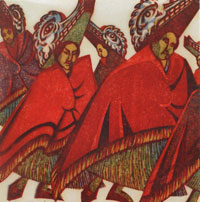
Indian Dance 1951
|
| 1951 |
In 1951 Sybil produced the new linocuts entitled "Gethsemane", another crucifixion scene - her "12th Station of the Cross", and her first completely Canadian subject, "Indian Dance". Indian Dance showed the Nootka first peoples ritual wolf dance, using four different colour panels of lino.
This led to her being elected to the Society of Canadian Painter-Etchers and Engravers in 1951. In 1952 "Indian Dance" was selected to be the Society's presentation print.
|
|
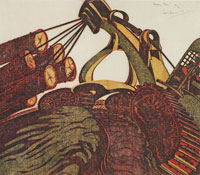
Logging Team 1952
|
| 1952 |
"Logging Team" of 1952 emphasises the machine more than the man in charge of it, but clearly the sense of line, movement and power is what makes the picture here. The subject reflects her "Timber Jim" of 1932, but the team of horses is now replaced by the caterpiller tracked machinery of a Canadian Logging Camp.
|
|

Mangolds Sybil Andrews 1956
|
| 1956 |
Her linocut entitled "Mangolds" doubtless has its origins in Woolpit, Suffolk, UK, but was produced in Canada in 1956.
|
|

Sybil Andrews and Walter
|
| 1960 |
This picture shows Sybil and Walter Morgan on the back porch of Willow Cottage at Campbell River. The picture is from the Campbell River Mirror, the local newspaper. The exact date of the picture is not known at present. Walter had lost his left arm at the elbow, and his prosthetic can be seen in this picture. He was adept at using his prosthetic as a tool in his work.
It was in 1960 that Sybil began to give formal weekly art classes at her home. Walter provided the students with wooden easels that he made in his workshop.
|
|

Trackway 1961
|
| 1961 |
In the 1960s Sybil's work included pieces which became more and more abstract. "Rock" of 1960 and "Sails" in the same year almost seemed to lose the subject in the abstraction. "Trackway" of 1961 was sometimes printed with the name "Piste". It depicts logging tracks through the dense forest and shows some of this abstraction.
|
|

Banner of St Edmund
|
| 1975 |
In 1975, the Bury born artist Sybil Andrews, now living in Canada, completed her great work, The Banner of St Edmund. It is hand embroidered in silks on linen, and was first conceived in the 1930s.
The distinctive design of the line of archers was first realised in a mural painted at "Tyrrells" in Woolpit in 1932.
The Liberty silks panel was sent to the London School of Weavers to be mounted as a banner for display purposes. Today this banner hangs in the Treasury of the St James Cathedral in Bury St Edmunds.
|
|
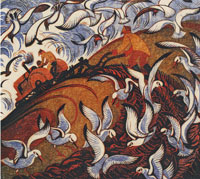
Wings 1979
|
| 1979 |
Wings is interesting from several points of view. Its origins as a subject from post war rural Suffolk is shown by the fact that the image was first conceived in 1946. The original blocks were a few of the plates which were melted in the hold of the ship which brought Andrews and Walter Morgan to Canada. By 1979 Sybil had recut this version which she issued in her usual edition of 60.
Despite her Canadian surroundings, which had produced many memorable images, she still returned in her imagination to the Suffolk countryside of her youth. As she wrote in September 1990, "Suffolk remains, what anyone can see, the core of what I am." (Letter from Sybil to Chris Reeves, St Edmundsbury Museum Service)
|
|

Sybil Andrews about 1980
|
| 1980 |
This photograph shows Sybil Andrews still producing work in her Willow Cottage studio at Campbell River, on Vancouver Island. She would have been 82 in 1980, but had produced "Wings" in 1979 and would go on to make "Fleece" in 1985 and "Six waterpots of stone" in 1988.
|
|
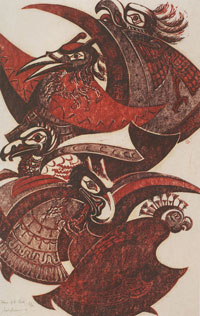
Dance of the Birds 1975
|
| 1982 |
The Dance of the Birds was a completely Canadian conception; one that could never have been produced in England. It was one of the items included in her nationwide exhibition.
In 1982 the Glenbow Museum of Calgary, Alberta, mounted a show of Sybil Andrews' complete series of colour linocuts. These exhibitions took place at the following venues:
- Vancouver Art Gallery, January - February;
- Mount Saint Vincent University, March - April;
- Art Gallery of Ontario, May - July;
- The Edmonton Gallery, August - September;
- Glenbow Museum, September - October;
- Norman Mackenzie Art Gallery, October - November;
- Art Gallery of Greater Victoria January - February 1983
She was now a celebrity in Canada, adopted as one of their own.
|
|
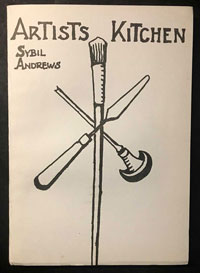
Sybil Andrews 'Artists Kitchen'
|
| 1985 |
In 1985 Sybil Andrews published a small book outlining her ideas and techniques of art, entitled "Artist's Kitchen". Another artist recorded these memories of her on the Sybil Andrews Heritage Website of Campbell River:
"My fondest memories are the afternoons we spent working together in her studio- Sybil working on her linocuts at her printing bench and me painting canvasses on the other side of the studio, normally on the wonderful easel which Walter had made...We would end the day with a cup of Earl Grey tea, homemade biscuits or fresh bread from the local bakery...Our discussions would range through art, religion and life in general...I recall her often saying that she strove for movement and form within her work and that for her, sharp angular curves best expressed the idea that everything was on the move and nothing stood still...I attended Sybil's classes for ten years before I came to London in 1985...I feel privileged to have been her close friend and I was honoured that she dedicated her book,'The Artists Kitchen' published in 1985, to me."
--Gary Ratushniak
|
|
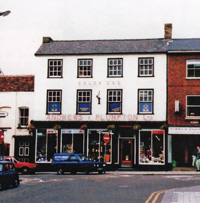
Andrews and Plumpton to move
|
| 1988 |
The old established ironmongers shop of Andrews and Plumpton had stood facing down Abbeygate Street since at least 1862. Competition from the new Do-it-Yourself superstores had reduced their business considerably. Determined to continue, the family decided to move to smaller premises in St Andrews Street, (South), actually just across the road from the rear entrance to their existing shop. Sadly this old family firm would close completely in March, 2000.
|
|
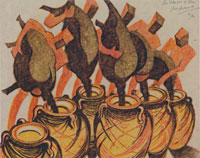
Six waterpots of stone 1988
|
| 1990 |
In 1990 Sybil donated the major part of her life's work to the Glenbow Museum of Calgary, Alberta. It consisted of over 500 items including oils, watercolours, drypoints, wood block prints and lino-cut prints.
Her final major piece of work continued one of the religious themes that she had always been producing over the years. Six Waterpots of Stone was made in 1988, and referred to the story of Jesus at the wedding in Cana, turning water into wine.
She also donated 7 linocuts and 8 watercolours and drawings together with 2 drawings by Cyril Power to the Museums collection of St Edmundsbury Borough Council, (Now the West Suffolk Council).
|
|
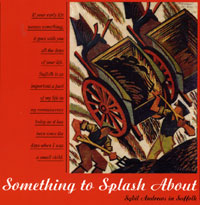
Sybil Andrews Exhibition
|
| 1991 |
In 1991 the St Edmundsbury Museum service prepared an exhibition of the work of Sybil Andrews. She was born in Bury in 1898 above Andrews and Plumpton's hardware shop at the top of Abbeygate Street. In 1922 she went to London, and in 1947 had emigrated to Canada. Christopher Reeve, the council's Fine Art Curator, wrote the accompanying commentary to the exhibition, called "Something to Splash About." Some of her pictures and Linocuts were displayed at Angel Corner, the council's clock museum at the time. Sybil Andrews wrote the introduction, sending a letter from her home in Canada. She died there in 1992.
The exhibition opened on 19th April, 1991, on Sybil Andrews' 93rd birthday.
|
|
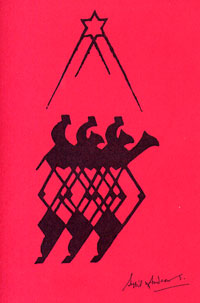
The Magi by Sybil Andrews
|
| 1992 |
On December 21st, 1992, the Bury St Edmunds born artist, Sybil Andrews, died at her home in Campbell River, Canada, aged 94. Unlike many of her contemporaries from the Grosvenor School of Art, she lived long enough to see a renewed interest in her work. She died knowing that her work was preserved in museums in Canada and in Britain.
At Sybil's request, her memorial service was held "at Hudson's Farm in North Campbell River beneath the many four hundred year old Douglas Fir trees and beautiful ancient maples, an area she and her Thursday art groups spent many hours sitting, sketching and painting. It was a peaceful ceremony read by Lorne Ritchie, one of her special art members, during a little downpour of rain".
In 1947 when Sybil and Walter had emigrated to Canada, she was quickly appreciated there for her artistic talents. Suffolk continued to influence her works throughout her life, despite a prolonged absence from the County. Even in Canada she continued to produce some work which reflected Suffolk life as she remembered it. Her linocuts and watercolours are now collected and exhibited internationally, and some were included in the permanent collection at the Manor House Museum, when it was open. One or two of her prints were found when the strongrooms at the Borough Offices were cleared prior to the move to Western Way by some Council departments in 1987.
The Magi was made for use as a Christmas card around 1946 it is believed.
|
|
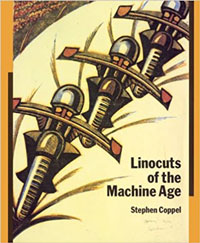
Linocuts by S Coppel
|
| 1995 |
This book published in 1995 was "Linocuts of the Machine Age: Claude Flight and the Grosvenor School" by S Coppel in association with the National Gallery of Australia. This was the definitive work on the key artists of the Grosvenor School. Among the most gifted of these were the English artists Cyril E. Power and Sybil Andrews, the Swiss artist Lill Tschudi, and the Australians Dorrit Black, Ethel Spowers and Eveline Syme
It contained a full catalogue raisonné of the work of Andrews, Power, Flight, Black, Spowers, Syme and Tschudi but had little appeal to a wider audience.
Currently out of print, used copies now sell for between £225 and £350.
The cover picture was "Speedway" by Sybil Andrews, one of her most dynamic linocuts, dating to 1934, at the height of her powers.
|
|
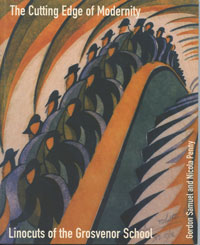
Linocuts of the Grosvenor School
|
| 2002 |
It is fair to say that only a few specialists had heard of Sybil Andrews or Cyril Power in the 20th century. The publication of this affordable book, "The Cutting Edge of Modernity - Linocuts of the Grosvenor School" by G Samuel and N Penny brought the whole subject of colour linocuts to a wider audience. It contained colour reprints of 48 stunning prints from the leading artists of the Grosvenor School. It was quickly re-printed in 2004. The cover is Cyril Power's 1930 work, "Whence and Whither".
|
|
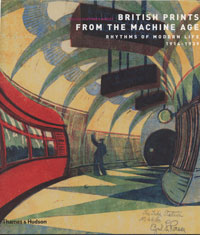
British Prints from the Machine Age
|
| 2008 |
This book, published in 2008, widened public interest in British modern art from between the two World Wars. It included examples from the Grosvenor School Artist, but also related these to followers of Vorticism and Italian Futurism. It supported an exhibition called "Rhythms of Modern Life 1914-1939" put on by the Museum of Fine Arts, Boston and the Metropolitan Museum of Art, New York at venues around the USA.
|
|
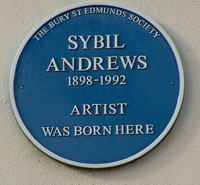
Sybil Andrews Blue Plaque
|
| 2012 |
In 2012 the Bury Society erected a series of seven Blue Plaques, commemorating local personalities, attached to buildings associated with each one. Sybil Andrews was naturally one of the people selected. At the time the building once known as Andrews and Plumpton Ironmongers shop at 90 Guildhall Street, where she was born, was occupied by The Royal Bank of Scotland.
|
|

Sybil Andrews birthplace and plaque
|
|
blank |
Here is how the plaque now looks on this building, which had been unoccupied for some while at the time of this photograph.
Financial support for this plaque was generously provided by the Sybil Andrews Heritage Society of Campbell River, Vancouver Island.
Fern Seaboyer of the Sybil Andrews Heritage Society, in communications about this plaque, reported that, "We had a connection with
Bonham's in London who sold some of Sybil's works in April, (2012). "Speedway" went
for 88,250 pounds, which they said was a world record for her."
|
|

Academy masterplan by Concertus
|
| 2015 |
Design and property consultancy Concertus was asked to produce a Master Plan for the design and construction of a new secondary school at Moreton Hall in Bury St. Edmunds. The brief was to design a school that would incorporate core facilities capable of supporting 900 students, with teaching accommodation for 600. The Master Plan also had to demonstrate the ability of the site to expand to accommodate 1400 pupils, plus a sixth form, by 2031.
The brief was delivered to Suffolk County Council in 2015.
On 11th September, 2015 the East Anglian Daily Times revealed the name of the new school:-
"The high school, which is due to open in September next year, will be called the Sybil Andrews Academy, inspired by the Bury St Edmunds artist and teacher who overcame many obstacles to achieve.
The first details about the academy, off Lady Miriam Way, were revealed in an interview with Howard Lay, chief executive of the Samuel Ward Academy Trust that will run it.
The trust already has seven schools, all within west Suffolk and including the high-performing Samuel Ward Academy in Haverhill.
He said the name Sybil Andrews had been chosen as she had an interesting life story for the school to build its values around.
She could not afford to attend art school and was a welder during the Second World War. She later became a teacher and a successful artist, emigrating to Canada after the war."
|
|
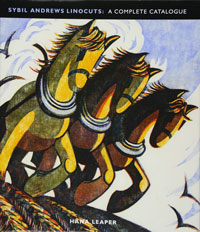
Sybil Andrews by H Leaper
|
|
blank |
In August 2015 Hana Leaper published her book "Sybil Andrews Linocuts: A Complete Catalogue". Leaper identified the prevalent themes in her work - sport, urban life, manual work and religion. This well presented publication features a complete catalogue of Andrews' linocuts, alongside a substantial essay contextualising Andrews' oeuvre and analysing the linocuts in detail.
However, it must be said that around West Suffolk the name Sybil Andrews remained completely unknown to the public until the building of the Sybil Andrews Academy guaranteed her name recognition and raised awareness locally.
|
|
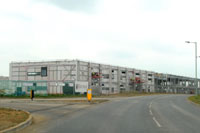
Sybil Andrews under construction
|
| 2016 |
In early September 2016 the new Sybil Andrews Academy opened its doors to its first students, but its brand new premises at Moreton Hall were not ready, so the Academy took over the buildings of the now defunct St James Middle School. The picture shows it under construction in March, 2016. This new Bury St Edmunds secondary school forms part of the Samuel Ward Academy Trust from Haverhill. It was hoped to take over the new Academy buildings in January, 2017, but in the event the students would be able to move in to the 'Heart Building' during late November, 2016. The sports complex would not be completed until 2017.
|
|

Sybil Andrews poster presentation
|
| 2018 |
On 20th April, 2018, this article appeared in the Bury Free Press covering the opening of a new exhibition of the work of Sybil Andrews in the Moyse's Hall Museum in Bury St Edmunds:-
"The family of Bury St Edmunds artist Sybil Andrews attended a special exhibition of her work yesterday on what would have been her 120th birthday.
Around 10 of Sybil Andrews’ cousins joined staff and school pupils from Sybil Andrews Academy, councillors and other community figures at Moyse’s Hall Museum in the town, where the exhibition will run until May 20.
The family also presented an old exhibition poster to the pupils of Sybil Andrews Academy, which will be displayed in the artist’s corner of the school library..........
The exhibition, which was organised by heritage officers Alex McWhirter and Dan Clarke, is thought to be the largest collection of the artist’s work outside of Canada.
It includes many prints and drawings, as well as the Sybil Andrews Edmund Tapestry, which is on loan from St Edmundsbury Cathedral.
“The most exciting part for me is the partnership work that has gone into the exhibition with all the different people and bodies contributing to it. It’s everyone together - a community project at its very best,” said Mr Clarke.
|
|

Graphic novel launch
|
|
blank |
In Canada, at Campbell River Museum, a project to promote public knowledge of Sybil Andrews was completed. After almost two years of research, planning, drawing, writing, editing, and fundraising, the Sybil Andrews graphic novel, "See With Your Own Eyes: The Sybil Andrews Story", went on sale on November 17th, 2018.
Ken Blackburn, is executive director of the Campbell River Arts Council and program manager of the Museum at Campbell River. He explained why the Arts Council was supporting the project:-
“As much as we try to raise the profile or talk about Sybil or do things with her name attached, it always just stays at a certain level, which is just sort of below the radar of the general public, for some reason,” Blackburn says. “So now we have a new tool – a new vehicle – to talk about Sybil that also has these wonderful social applications to it, as well.”
|
|
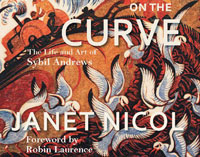
On the Curve by J Nicol
|
| 2019 |
In 2019 the Campbell River area of Canada produced a second book on the life and art of Sybil Andrews.
Janet Nicol is a freelance writer with a special interest in art, history and social justice. She taught history for 29 years in Vancouver and has been a long-time volunteer for various historical organizations.
According to "The Campbell River Mirror" of May 31st, 2019,:-
"She has written over 350 articles for 47 magazines, but she decided to take a look at our very own Sybil Andrews in her latest work, entitled 'On the Curve: The Life and Art of Sybil Andrews', a 160-page paperback set to be released to the public this Saturday at the Museum at Campbell River......
Although she was raised in Bury St Edmunds, England, 'On the Curve' focuses on Andrews’ life after she immigrated to Canada in 1947....
In the final years of her life, retrospective exhibitions of her prints in Canada and Britain skyrocketed her popularity. The City of Campbell River has recognized her as one of our most important figures, naming her April 19 birthday as Sybil Andrews Day in the city, as well as preserving her cottage as the first – and still only – heritage property on the Heritage Registry."
|
|
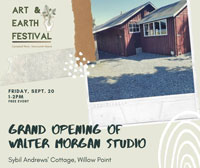
The Walter Morgan Arts Studio
|
|
blank |
In September, 2019, another arts project was launched in Campbell River. This was the opening of the Walter Morgan Studio at Willow Point. The renovations on Walter Morgan’s old workshop and studio behind their cottage at Willow Point were completed and the grand opening of the studio took place on September 20th, serving as the unofficial kick-off to the local Art & Earth Festival.
The Campbell River Museum Facebook page recorded the event:
"Walter Morgan (Sybil Andrews' husband) built most of it and used it as a boat shed and workshop. After the Campbell River Arts Council began to use Willow cottage, they used this adjacent building for storage and summer camps for kids.
The building foundation rotted over time and City of Campbell River - City Hall came through and stabilized the building without damaging the historic exterior."
Walter William James Morgan was the husband of renowned artist and teacher Sybil Andrews, and according to Sandra Parrish, executive director of the Museum at Campbell River, he was an amazing man whose legacy should be celebrated alongside his wife’s. While Sybil is celebrated all over the world – and especially here in Campbell River – Walter has been, in some ways, forgotten by comparison."
“An essential part of any relationship, such as that of Sybil and Walter, is the ability for two people to complement each other,” Parrish says. “They were a prime example of that. They were, in the truest sense of the word, a couple.”
But Walter, himself, was also an extraordinary man in his own right. At the ages of 53 and 49, Walter and Sybil left England for British Columbia to start a new life together after the devastation of England during the second world war. Although missing an arm, Walter built his own workshop to build boats and any other wood products required, while also renovating the old cottage for their home. He was also a talented musician and trumpet player.
|
Originally prepared for this St Edmundsbury Chronicle website
by David Addy, April 19th 2020
RESOURCES USED
I am grateful to descendants and relatives of Sybil Andrews for supplying some of the photographs and details used in this website.
Various extracts from the Bury Free Press and East Anglian Daily Times, where shown.
Author's collection of postcards
"Something to Splash About" booklet written by Chris Reeve, St Edmundsbury Museum Services, 1991.
"Linocuts of the Machine Age", Definitive catalogue raisonné by S Coppel 1995
"The Cutting Edge of Modernity - Linocuts of the Grosvenor School" by G Samuel and N Penny, 2002
C S Ackley, "British Prints from the Machine Age, Rhythms of modern life, 1914-1939", 2008
Philip Vann "Cyril Power Linocuts: A Complete Catalogue" 2008 and 2013 in hardback
"Sybil Andrews Linocuts: A Complete Catalogue" by Hana Leaper 2015
The Sybil Andrews Heritage Website; https://www.sybilandrews.com/
|










































































